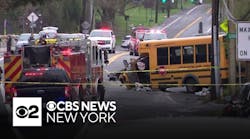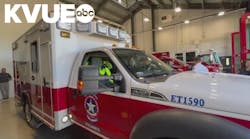Nov. 16--Scientists at Boulder's National Center for Atmospheric Research this week are touting a recently developed computer modeling technique they say can provide accurate predictions of the growth and behavior of long-lived wildfires.
The approach to wildfire mapping, detailed in a study that appeared this week in an online issue of Geophysical Research Letters, is the result of a partnership between NCAR and scientists at the University of Maryland.
The technique uses newly available, fine-scale satellite data collected on active wildfires, combined with advanced simulations of the interactions of fire and weather, to offer its forecasts, according to its developers.
"Mostly wildfires have been dealt with by foresters, but when we looked at them with our atmospheric scientist eyes, we saw a lot of things we understood from studies of thunderstorms and other meteorological phenomena," NCAR scientist Janice Coen said.
Coen has been with NCAR for 21 years and has a background in atmospheric modeling of air over complex terrain. She said the model takes into account not only the effects of winds on fire, but also fire's effects on weather.
"As the fire consumes fuel, it produces heat and water vapor," she said. "This makes the air warmer than the air around it, so it wants to rise, and more air has to move in to the base of the column to replace it, so that affects the winds near the fire."
Coen, who worked with University of Maryland professor Wilfrid Schroeder on the model and was lead author of the study, said that by "cycling," or updating the fire behavior model with fresh satellite data every 12 to 24 hours, the scientists showed they could forecast fire growth and behavior.
Using data collected during New Mexico's devastating Little Bear Fire in 2012, scientists were retrospectively able to show the modeling technique could accurately forecast fire growth, even without being able to directly account for variables such as firefighter activity and spotting.
"We know every 12 hours we're going to have a fresh satellite map," Coen said. "By repeating this for 12 to 24 hours, we learned we could simulate the whole life cycle of a fire form ignition to extinction, and we can do it well, which is important."
Coen developed the computer model, known as the Coupled Atmosphere-Wildland Fire Environment, and Schroeder produced a higher-resolution satellite instrument, known as the Visible Infrared Imaging Radiometer Suite, according to NCAR. The instrument, operated by NASA and the National Oceanic and Atmospheric Administration, covers the entire globe in 12 hours or less and provides infrared images with pixels that represent spaces roughly 1,200 feet across, according to NCAR.
In the past, similar instruments provided less detailed images where each pixel was slightly more than a half-mile across, making it impossible to distinguish between burning and already burnt areas around an active fire.
"The transformative event has been the arrival of this new satellite data," Schroeder said in a news release. "The satellite data has tremendous potential to supplement fire management and decision support systems, sharpening the local, regional and continental monitoring of wildfires."
Coen pointed to numerous potential real-world applications for the modeling, with the most obvious being that it could provide information for firefighters and fire managers that may prevent dangerous or even deadly situations, like the one that claimed the lives of 19 firefighters in Arizona this summer.
She said it may also be able to identify fires in their formative stages to allow for better resource allocation and prioritization if multiple fires are burning in the same region.
"There are so many factors that come together to make a fire suddenly intensify that even highly trained people cannot anticipate when this is going to happen," Coen said. "This is another tool in people's tool box for making decisions."
Boulder County wildfire management officer Jay Stalnacker said he had heard about the new modeling technique and thinks it is a great idea. But, he noted, its usefulness during an active fire has not been determined just yet.
"I think the practicality of it is going to be all up to the guys and gals on the ground and how the interface takes place between the tools and the fire manager," he said. "A wildfire is a natural disaster. It's Mother Nature and her fury. No matter what tools you give us -- heavy air tankers, unlimited water, satellite imaging -- Mother Nature is going to do what she needs to do."
Coen said the next step is to secure additional funding -- between $1 million and $2 million -- to continue developing the modeling technique. She expects it to be ready for a limited test on a live fire in the next one to two years.
Contact Camera Staff Writer Joe Rubino at 303-473-1328, [email protected] or twitter.com/JoeCarmenRubino.
Copyright 2013 - Daily Camera, Boulder, Colo.





